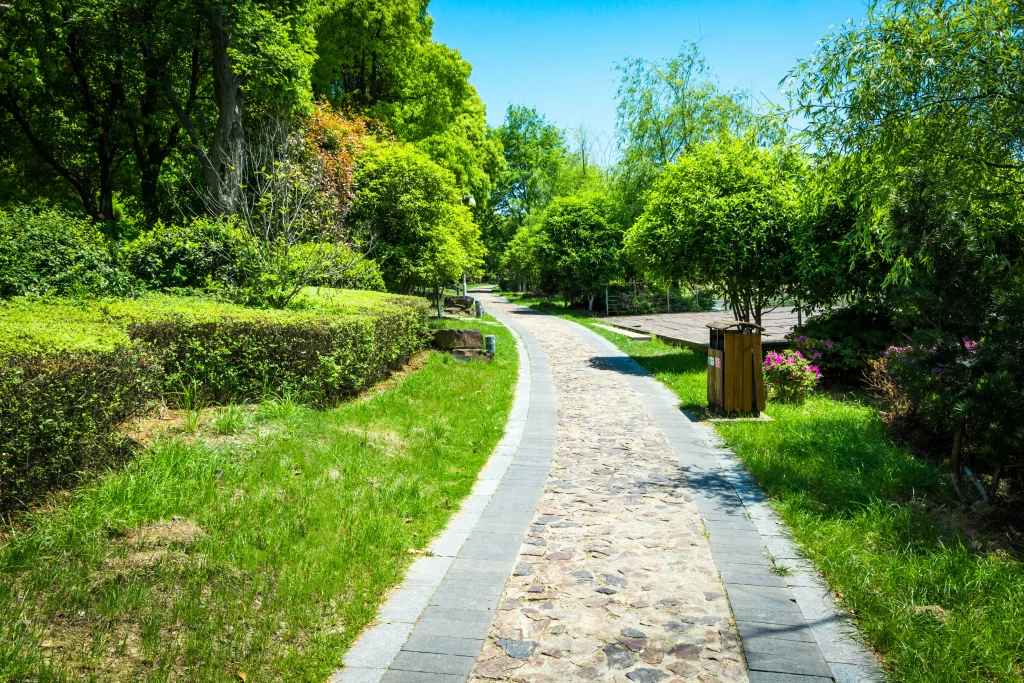Lawn discoloration presents a common challenge for Denver homeowners. Those distinctive brown or reddish patches appearing across your otherwise green yard signal underlying issues that require proper diagnosis and treatment. While these spots might seem alarming at first glance, understanding their cause allows for targeted, effective solutions.
Brown or reddish-brown patches on your lawn can result from various issues, such as fungal infections like red thread or brown patch, pet urine, drought stress, or insect infestations. To identify the precise cause, it’s beneficial to inspect your lawn for particular indicators and take into account factors like weather patterns and your lawn maintenance habits.
This comprehensive guide will help you identify what’s causing those troublesome spots and outline practical solutions to restore your lawn’s health and appearance.
What Do Brown and Red Lawn Spots Mean?
Lawn spotting refers to distinct areas of discoloration that contrast with the surrounding healthy grass. Brown spots typically indicate dead or dying grass resulting from various stressors—inadequate water, soil problems, or pest activity. These areas appear dry, brittle, and lifeless when inspected closely.
Red spots, by contrast, often signal fungal infections. The reddish tint comes from microscopic fungal organisms that attach to grass blades, causing discoloration as they feed on plant tissue. Both types of spotting can spread if left untreated, eventually compromising large sections of your lawn.

The Most Common Causes of Brown and Red Spots in Lawns
Lawn Fungal Diseases
Fungal diseases rank among the most common causes of lawn discoloration in Colorado. These microscopic organisms thrive in specific environmental conditions, particularly during periods of high humidity combined with warm temperatures.
- Rust fungus appears as orange-red powdery spores on grass blades, leaving a rusty residue when touched.
- Brown patch creates circular or irregular brown areas ranging from a few inches to several feet in diameter, with a distinctive darker ring around the perimeter.
- Red thread produces pinkish-red threads extending from grass tips, visible upon close inspection, especially during damp mornings.

Solution for Lawn Fungal Diseases:
- Treat fungal infections by applying appropriate fungicides according to manufacturer specifications.
- Maintain proper mowing height (typically 2.5-3 inches for most Colorado grasses) to reduce humidity at soil level.
- Adjust watering schedules to early morning hours, allowing grass to dry throughout the day.
Preventing Fungal Lawns: Regular lawn maintenance significantly reduces fungal disease risk.
- Core aeration improves soil drainage and reduces thatch, creating less hospitable conditions for fungi.
- Overseeding with disease-resistant grass varieties builds lawn resilience.
- Reduce lawn humidity by pruning overgrown shrubs and trees to improve air circulation.
Pet Urine Damage
Dog urine contains concentrated nitrogen compounds that essentially “burn” grass when applied in high concentrations.
Pet urine damage creates distinctive circular yellow or brown patches surrounded by a darker green ring. This pattern results from nitrogen concentration—burning the center while fertilizing the edges.
Female dogs typically cause more damage than males due to differences in urination patterns.
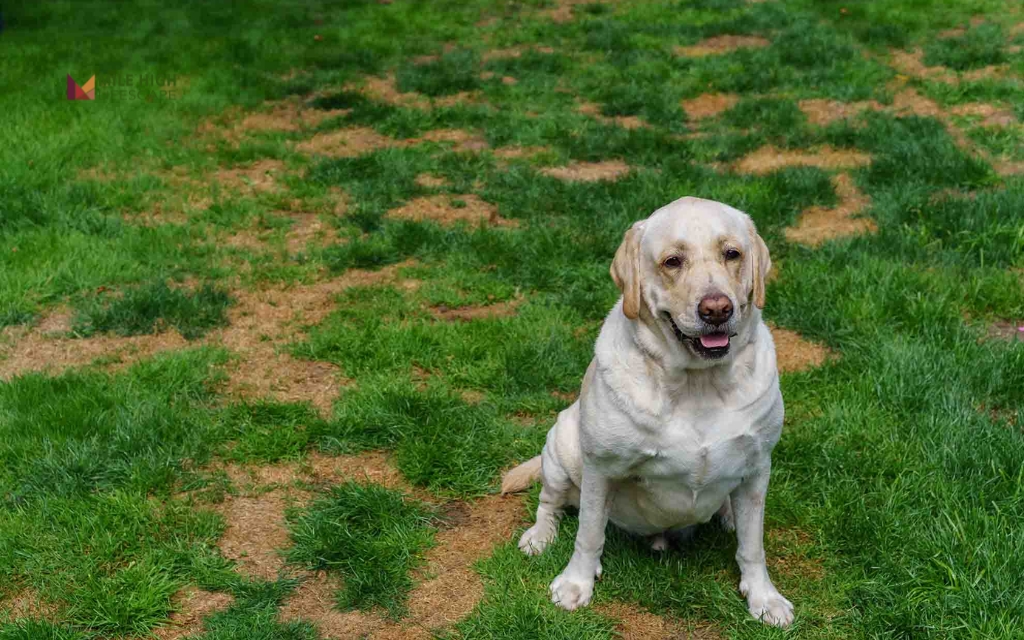
Solutions for Pet Urine Damage:
- Water affected areas deeply and immediately after pet urination to dilute the nitrogen concentration.
- For existing damaged spots, remove dead grass, add a thin layer of topsoil, and reseed with appropriate grass varieties.
- Consider commercial products designed to neutralize urine effects, available at most lawn care retailers.
Prevention for Pet Urine Damage:
- Train pets to use specific areas of the yard covered with materials like gravel or mulch.
- Maintain consistent hydration for your lawn, as well-watered grass tolerates urine exposure better than drought-stressed turf.
- Create designated pet relief areas using dog-friendly landscaping approaches.
Drought Stress & Irrigation Issues
Colorado’s arid climate makes drought stress a persistent lawn challenge, especially during summer months.
Drought-stressed lawns develop dry, crunchy texture underfoot. Grass blades turn from vibrant green to bluish-gray before browning. Footprints remain visible for extended periods after walking across the lawn.
Areas fail to recover despite occasional watering, and soil beneath affected areas feels dry several inches down.
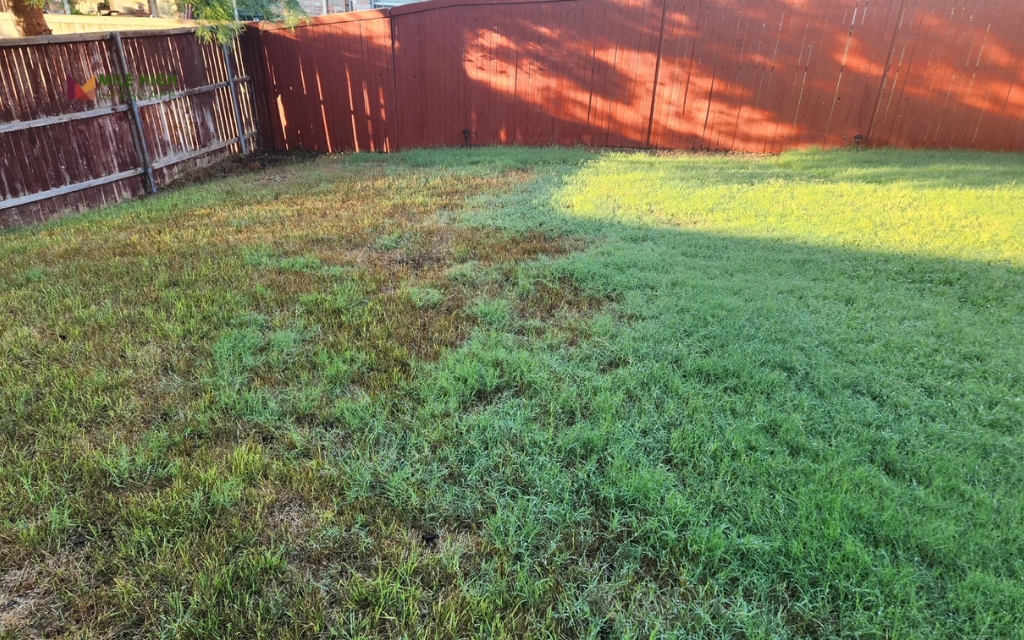
Solution for Drought Stress & Irrigation Issues:
- Water deeply but infrequently to encourage deep root growth—typically 1-1.5 inches of water per week, applied in 2-3 sessions.
- Check sprinkler system coverage using catch cups to identify under-watered sections.
- Adjust sprinkler heads to ensure even distribution and prevent both over and under-watering.
Prevention for Drought Stress & Irrigation Issues:
- Implement consistent watering schedules based on seasonal needs, with more frequent irrigation during hot summer months.
- Consider installing smart irrigation controllers that adjust watering based on weather conditions.
- For chronic problem areas, consider shifting to drought-tolerant grass varieties like buffalo grass or blue grama.
Soil Compaction and Thatch Build-Up
Heavy foot traffic, construction activities, or years of neglect can lead to compacted soil that restricts root growth and water infiltration.
Compacted areas show stunted growth despite adequate water and fertilizer. The soil feels hard to the touch and resists penetration when probed with a screwdriver. Water pools on the surface rather than absorbing into the ground.
Thatch—a layer of dead organic material—exceeds half an inch in thickness when measured.
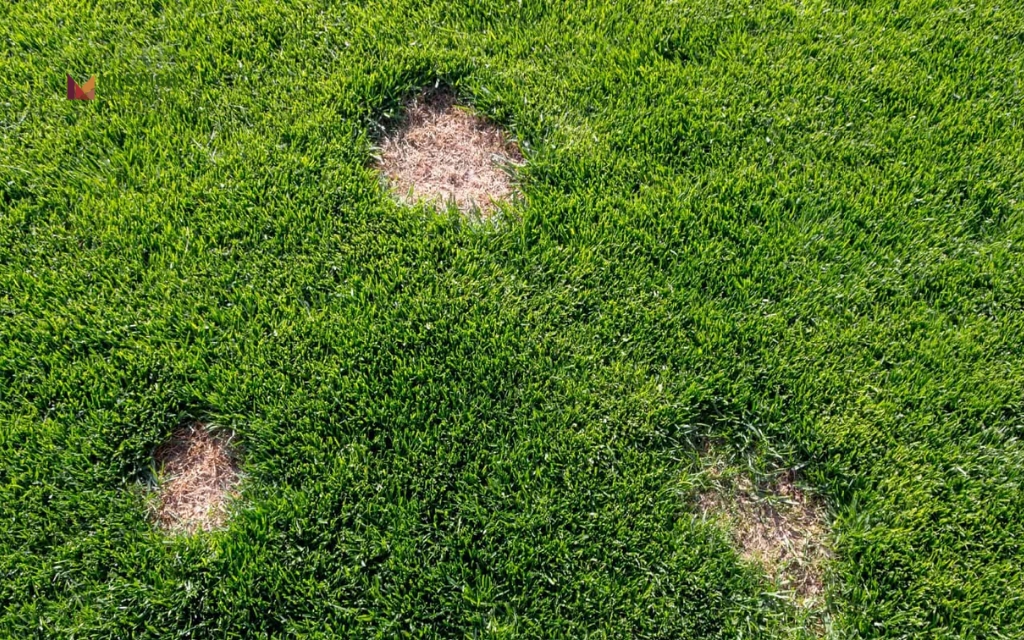
Solution for Soil Compaction and Thatch Build-Up:
- Core aeration removes small plugs of soil, creating channels for water, air, and nutrients to reach grass roots.
- Dethatching removes the accumulated layer of dead grass material.
Both services typically require specialized equipment available through professional lawn care providers.
Prevention for Soil Compaction and Thatch Build-Up:
- Schedule annual core aeration, especially for high-traffic lawns.
- Top-dress with compost after aeration to improve soil structure.
- Reduce compaction by creating designated pathways through frequently traversed areas.
- Consider permeable hardscaping for extremely high-traffic zones.
Grub or Insect Damage
White grubs—the larval stage of beetles—feed on grass roots, causing significant lawn damage when present in large numbers.
Grub-damaged grass easily lifts from the soil like a loose carpet due to severed root systems. Affected areas yellow, then brown rapidly, particularly during late summer.
Increased bird, raccoon, or skunk activity targeting your lawn indicates possible grub presence, as these animals feed on the larvae.
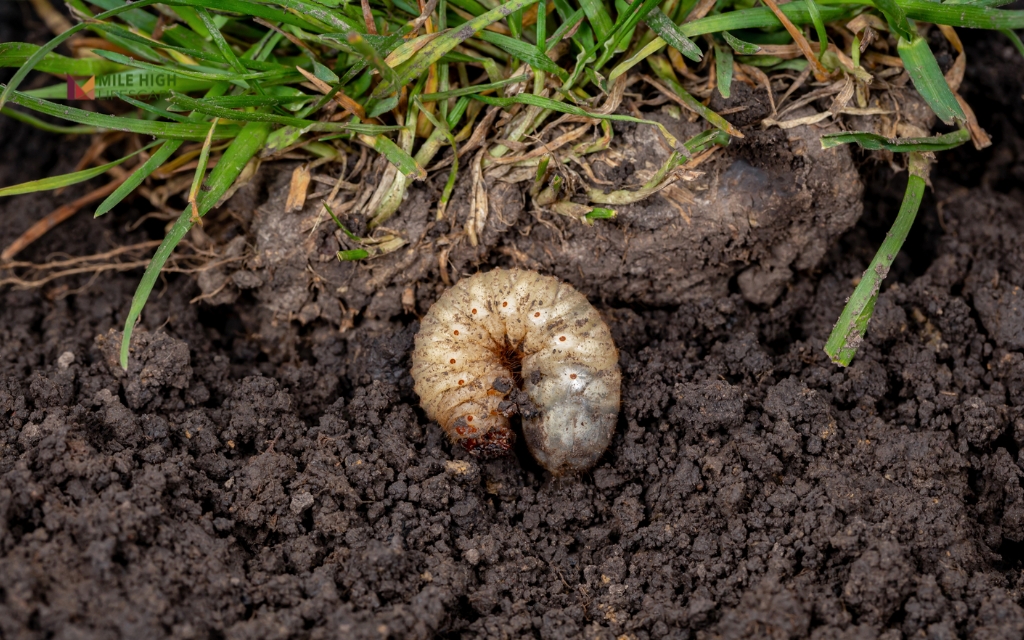
Solution for Grub or Insect Damage:
- Apply beneficial nematodes or milky spores for natural grub control.
- For severe infestations, targeted insecticides specifically formulated for grubs provide effective control when applied at the right life cycle stage (typically late summer).
Water the lawn thoroughly after application to help treatments reach the soil level where grubs feed.
Prevention for Grub or Insect Damage:
- Maintain healthy, vigorous turf through proper fertilization and watering, as stronger lawns better tolerate low grub populations.
- Routinely inspect your lawn by cutting and lifting small sections to check for grub presence.
- Apply preventive treatments when grub history exists in your neighborhood.
Fertilizer Burns
Improper fertilizer application remains a common cause of lawn spotting, especially when products are applied unevenly or at excessive rates.
Fertilizer burn appears as yellow or brown streaks or patches that follow application patterns. Damaged areas typically align with fertilizer spreader paths or show concentrated damage where product spilled.
Grass in affected areas appears dry, brittle, and discolored, with damage occurring rapidly after fertilizer application.
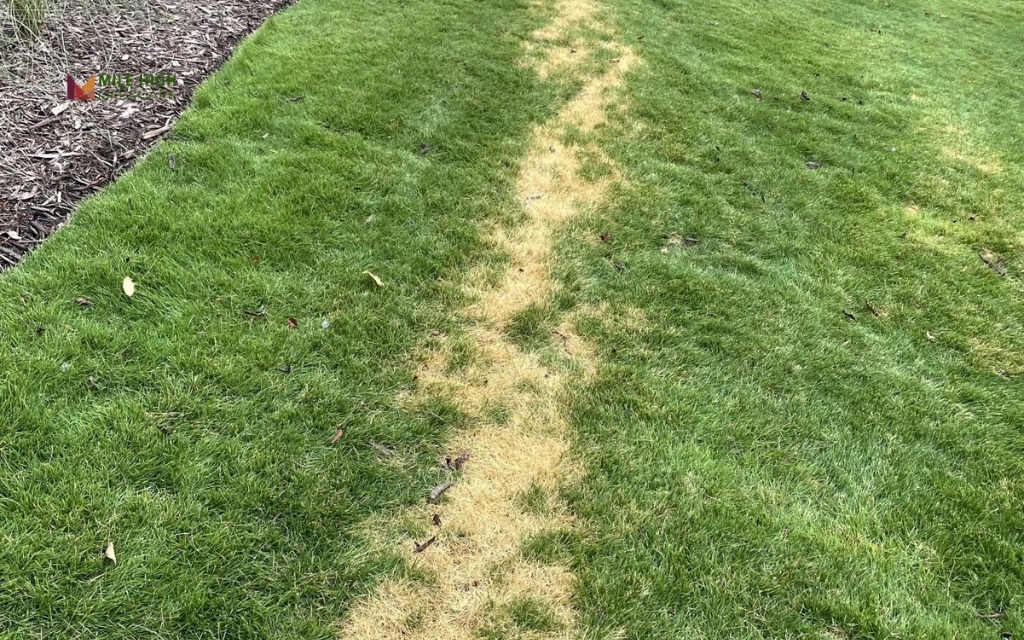
Solution for Fertilizer Burns:
- Immediately water affected areas thoroughly to dilute and flush excess fertilizer from soil and grass blades.
- Remove dead grass once damage stabilizes, then reseed bare patches.
For severe damage, consider adding a layer of fresh topsoil before reseeding to dilute remaining fertilizer concentration.
Prevention for Fertilizer Burns:
- Follow manufacturer guidelines precisely regarding application rates and timing. Use a properly calibrated spreader to ensure even distribution.
- Apply fertilizer to dry grass, then water thoroughly afterward.
- Split applications into half-rate doses applied two weeks apart rather than applying full strength at once.
How Mile High Lifescape Can Help You?
Mile High Lifescape approaches lawn problems systematically, beginning with comprehensive inspection and soil testing to identify the specific causes of your lawn’s discoloration. Our certified technicians utilize professional diagnostic methods that go beyond surface symptoms to address root causes.
We develop customized treatment plans based on your lawn’s specific needs, considering soil composition, grass variety, sun exposure, and Denver’s regional climate factors. Our solutions incorporate both immediate remediation and long-term prevention strategies.
One client in Westminster experienced recurring red patches despite multiple DIY treatment attempts. Our team identified a combination of fungal disease and irrigation imbalance that required a coordinated approach. After implementing our recommended treatments, their lawn showed significant improvement within three weeks and returned to full health within two months.
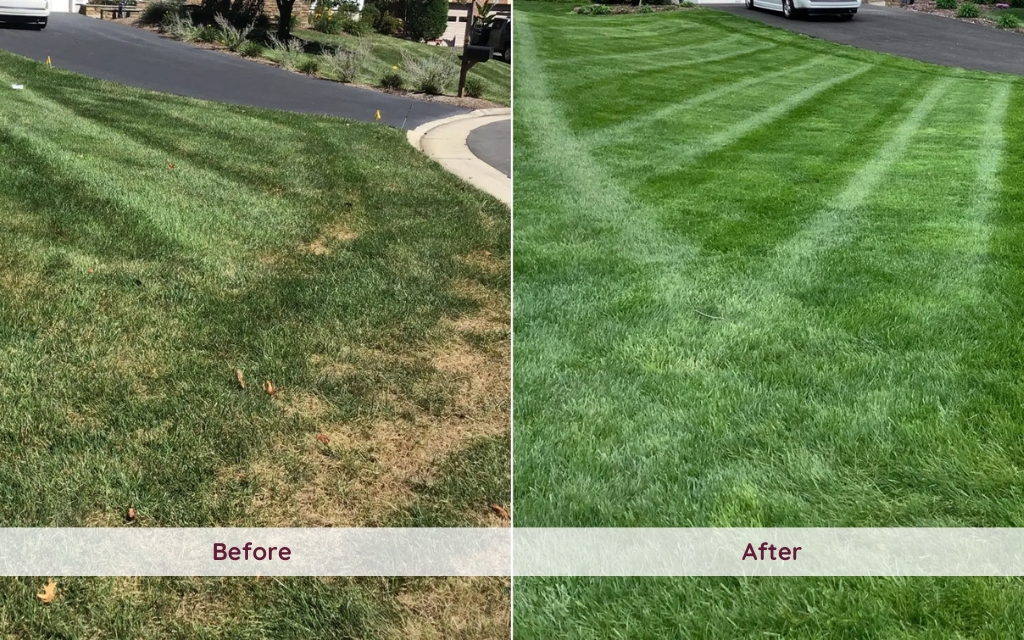
Another Denver homeowner struggled with persistent brown patches across their front yard. Our soil analysis revealed severe compaction combined with thatch buildup. Following our core aeration and overseeding program, the lawn transformed from patchy and stressed to lush and resilient.

Schedule your Free Quote or Seasonal Lawn Care Check today. Our expert team will diagnose your lawn’s issues and provide clear, effective solutions tailored to your property’s specific needs.
Conclusion
Identifying and addressing the underlying causes of lawn discoloration represents the first critical step toward restoring your yard’s health and appearance. Whether facing fungal diseases, irrigation problems, or pest damage, prompt, targeted intervention prevents further spread and minimizes recovery time.
Mile High Lifescape brings nearly two decades of specialized lawn care experience in Denver’s unique climate. Our expert technicians deliver customized solutions for any lawn spotting issue, helping you achieve and maintain the vibrant, healthy landscape you desire.
Contact us today for your Free Quote and discover how our professional approach can transform your lawn challenges into lasting solutions.
Frequently Asked Questions (FAQs)
Why are parts of my lawn turning red or brown but not the whole yard?
Localized discoloration typically indicates specific stress factors affecting only certain lawn areas. Common causes include uneven watering coverage, soil composition differences, or localized pest activity. These variations create conditions where some grass areas thrive while others struggle under stress.
How do I know if it’s a fungus or just pet damage?
Pet damage usually appears in circular patterns with distinctive darker green rings around brown centers, predominantly near areas where pets frequently urinate. Fungal damage typically shows irregular spreading patterns, sometimes with visible fungal structures like threads or powdery residue, especially noticeable during morning dew periods.
Can hot weather cause lawn discoloration like this?
Yes, extended heat periods cause drought stress that manifests as bluish-gray discoloration before turning brown. Heat-stressed lawns recover quickly with proper watering, while disease or pest damage requires specific treatments beyond irrigation adjustments.
Is it safe to use store-bought fungus treatments myself?
Store-bought fungicides can effectively treat minor fungal infections when applied according to manufacturer instructions. However, misdiagnosis or improper application often leads to wasted product and persistent problems. Professional diagnosis ensures you’re treating the actual cause rather than symptoms.
How long does it take to repair lawn spots with Mile High Lifescape?
Recovery timelines vary based on damage severity, underlying causes, and seasonal growing conditions. Minor discoloration typically shows improvement within 2-3 weeks after treatment. Severe damage requiring reseeding generally shows substantial recovery within 30-45 days during growing season, with complete restoration often achieved within one full growing cycle.
